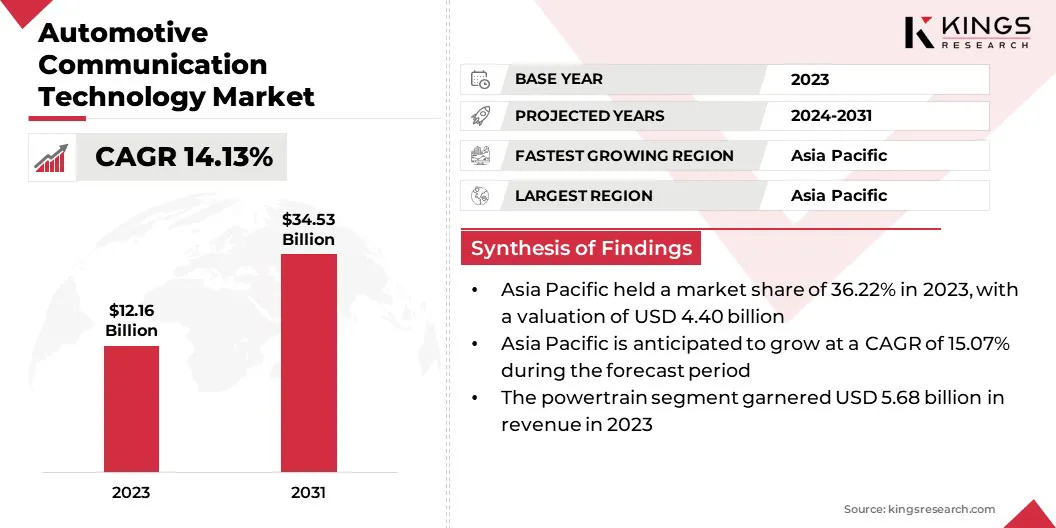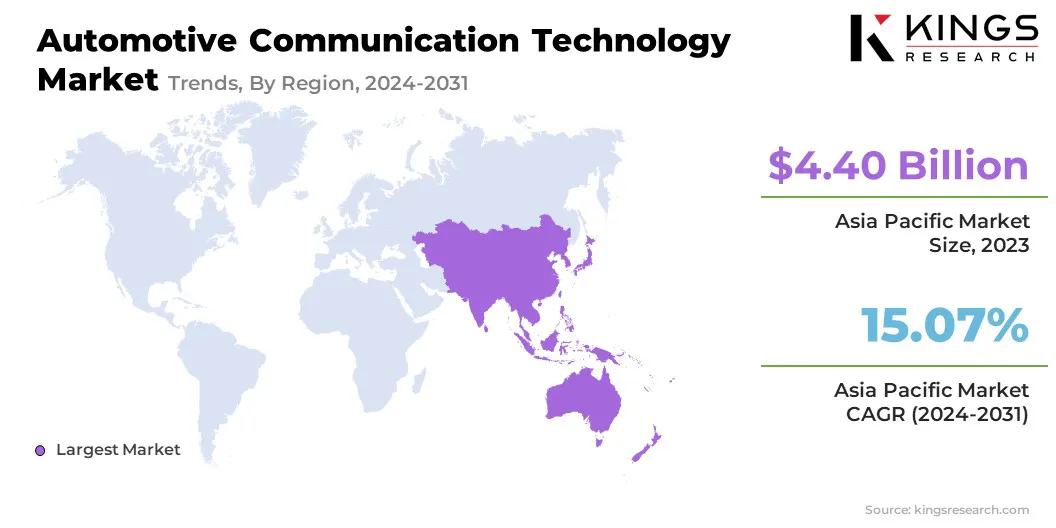Automotive and Transportation

Automotive Communication Technology Market

Automotive Communication Technology Market Size, Share, Growth & Industry Analysis, By Vehicle Type [Passenger Cars, Commercial Vehicles, Electric Vehicles], By Technology [CAN (Controller Area Network), LIN (Local Interconnect Network), Media-Oriented Systems Transport, Others], By Application, and Regional Analysis, 2024-2031
Pages : 140
Base Year : 2023
Release : March 2025
Report ID: KR1521
Market Definition
The market encompasses advanced in-vehicle communication systems, enabling seamless interaction between cars, infrastructure, and devices.
This includes technologies such as vehicle-to-everything, infotainment systems, and telematics, facilitating improvements in safety, connectivity, autonomous driving, and user experience. Market growth is fueled by the rising demand for smart, connected vehicles.
Automotive Communication Technology Market Overview
Global automotive communication technology market size was USD 12.16 billion in 2023, which is estimated to be valued at USD 13.69 billion in 2024 and reach USD 34.53 billion by 2031, growing at a CAGR of 14.13% from 2024 to 2031.
Advancements in autonomous driving require seamless communication between vehicles and infrastructure to enable real-time data exchange, enhance safety, and ensure efficient traffic management. This growing need for reliable communication systems is driving the development of automotive communication technologies.
Major companies operating in the automotive communication technology industry are Continental AG, Robert Bosch GmbH, Aptiv, Qualcomm Technologies, Inc, DENSO, Infineon Technologies AG, NXP Semiconductors, Autotalks, Cohda Wireless, Huawei Technologies Co., Ltd, TomTom International BV, ARASAN CHIP SYSTEMS INC., Traquair Data Systems, Inc., Contemporary Control Systems, Inc., Softing AG, and others.
The market is rapidly evolving with the integration of advanced communication systems in vehicles. As automobiles become smarter and more connected, the demand for robust, real-time communication between vehicles, infrastructure, and external devices intensifies.
This technology enhances safety, supports autonomous driving, and improves user experiences through infotainment and telematics systems. Innovations in 5G, IoT, and V2X technologies are expected to further fuel market expansion.
- In August 2024, LG Innotek accelerated its expansion into the automotive communication market with its next-generation Digital Key solution. Designed to enhance security, localization accuracy, and compatibility, this innovation strengthens LG Innotek's position as a leader in the sector, with mass production slated for 2027.

Key Highlights:
- The global automotive communication technology market size was recorded at USD 12.16 billion in 2023.
- The market is projected to grow at a CAGR of 14.13% from 2024 to 2031.
- Asia-Pacific held a share of 36.22% in 2023, valued at USD 4.40 billion.
- The passenger cars segment garnered USD 5.49 billion in revenue in 2023.
- The CAN (Controller Area Network) segment is expected to reach USD 15.78 billion by 2031.
- The infotainment & communication segment is anticipated to witness the fastest CAGR of 15.81% over the forecast period
- North America is anticipated to grow at a CAGR of 14.62% % during the forecast period.
Market Driver
Advancements in Autonomous Driving
Advancements in autonomous driving is fueling the growth of the automotive communication technology market. The rise of self-driving vehicles highlights the need for seamless communication between vehicles, infrastructure, and devices to improve safety, real-time navigation, and efficient traffic management.
Technologies such as vehicle-to-everything () and 5G connectivity enable this interaction, allowing vehicles to communicate with traffic signals, pedestrians, and other vehicles to optimize routes and avoid collisions. This demand for reliable communication systems is accelerating innovation in the market.
- In May 2024, Wayve raised USD 1.05 billion in Series C funding led by SoftBank, with contributions from NVIDIA and Microsoft, to advance its mission of developing embodied AI products for automated driving, revolutionizing mobility through intelligent, adaptable driving systems.
Market Challenge
High Cost
High costs of developing and integrating advanced automotive communication technologies pose a significant challenge to the market, particularly for smaller manufacturers. These costs arise from substantial investments in research and development (R&D), hardware, and infrastructure.
To address this challenge, manufacturers can form strategic partnerships, collaborate on shared platforms, and leverage economies of scale to reduce costs. Additionally, leveraging government incentives and subsidies for technological innovation can help offset expenses, making advanced communication technologies more accessible to a broader range of manufacturers.
Market Trend
Growth of V2X Communication
The growth of vehicle-to-everything (V2X) communication technology is a key trend influemcing the automotive communication technology market, enabling vehicles to interact with other vehicles, infrastructure, and pedestrians. This integration enhances road safety by reducing collisions, optimizing traffic flow, and enabling real-time data exchange.
Advancements V2X technology are leading to the development of smart cities and autonomous vehicles by ensuring seamless communication within the transportation ecosystem. Its growing adoption is enhancing road safety and efficiency worldwide.
- In January 2023, Danlaw, Inc. acquired Cohda Wireless, a leader in Vehicle-to-Everything (V2X) technology. This acquisition aims to advance connected vehicle safety, smart city solutions, and global expansion by combining both companies' expertise to revolutionize transportation and urban environments through advancements in V2X innovation.
Automotive Communication Technology Market Report Snapshot
|
Segmentation |
Details |
|
By Vehicle Type |
Passenger Cars, Commercial Vehicles, Electric Vehicles (EVs) |
|
By Technology |
CAN (Controller Area Network), LIN (Local Interconnect Network), Media-Oriented Systems Transport (MOST), Others |
|
By Application |
Powertrain, Infotainment & Communication, Body Control & Comfort, Others |
|
By Region |
North America: U.S., Canada, Mexico |
|
Europe: France, UK, Spain, Germany, Italy, Russia, Rest of Europe |
|
|
Asia-Pacific: China, Japan, India, Australia, ASEAN, South Korea, Rest of Asia-Pacific |
|
|
Middle East & Africa: Turkey, UAE, Saudi Arabia, South Africa, Rest of Middle East & Africa |
|
|
South America: Brazil, Argentina, Rest of South America |
Market Segmentation
- By Vehicle Type [Passenger Cars, Commercial Vehicles, and Electric Vehicles (EVs)]: The passenger cars segment earned USD 5.49 billion in 2023 due to rising demand for advanced connectivity features and enhanced driver assistance systems in mainstream vehicles.
- By Technology [CAN (Controller Area Network), LIN (Local Interconnect Network), Media-Oriented Systems Transport (MOST), and Others]: The CAN segment held a share of 45.62% of the market in 2023, propelled by its widespread adoption for in-vehicle networking and reliable data communication.
- By Application (Powertrain, Infotainment & Communication, Body Control & Comfort, and Others): The infotainment & communication segment is projected to reach USD 15.12 billion by 2031, owing to the increasing integration of smart connectivity and multimedia systems in modern vehicles.
Automotive Communication Technology Market Regional Analysis
Based on region, the global market has been classified into North America, Europe, Asia Pacific, Middle East & Africa, and Latin America.

Asia Pacific automotive communication technology market share stood at around 36.22% in 2023, valued at USD 4.40 billion. Countries such as China, Japan, and South Korea are boosting the adoption of connected vehicle systems, including V2X (vehicle-to-everything), due to rapid technological advancements and government-backed initiatives.
The demand for enhanced vehicle safety, real-time communication, and smart infrastructure is propelling regional market growth. The region’s large automotive production base and increasing focus on smart cities further fuel its market leadership.
North America automotibe communication technology market is poised to grow at a robust CAGR of 14.62% over the forecast period. The region is seeing a significant rise in the adoption of connected vehicles, supported by the increasing demand for improved safety features, real-time communication, and smarter infrastructure.
With advancements in vehicle-to-vehicle (V2V) and vehicle-to-infrastructure (V2I) technologies, the regional market is set to lead innovation in the near future. With ongoing advancements in automakers and technology providers, the North America market is likely to experience rapid growth and transformation in the coming years.
- In December 2024, U.S.-based Karma Automotive partnered with COVESA, UC Riverside, and ROADMEDIC.AI to develop software standards for next-gen 9-1-1 emergency vehicle communication. This collaboration enhances automotive communication technology, enabling real-time crash data transmission to emergency responders and improving response times and safety.
Regulatory Frameworks
- In the U.S., the Federal Communications Commission (FCC) regulates interstate and international communications through cable, radio, television, satellite and wire to ensure connectivity.
- In the U.S., the National Highway Traffic Safety Administration (NHTSA) oversees motor vehicle safety by investingating defects, enforcing fuel economy standards, addressing drunk driving risks, and promoting safety measures such as safety belts and air bags.
- The EU General Data Protection Regulation (GDPR) governs the processing and transfer of personal data to protect individual privacy.
Competitive Landscape
The automotive communication technology industry is highly competitive, with numerous players offering innovative solutions for connected vehicles, autonomous driving, and electrification.
Companies are focusing on enhancing vehicle-to-vehicle (V2V) and vehicle-to-everything (V2X) communication systems, as well as improving data security and interoperability. Strategic partnerships, acquisitions, and investments in R&D are driving technological advancements and market growth.
- In January 2025, Aptiv presented its advanced ADAS, next-gen in-cabin experiences, and power distribution technologies at CES, highlighting innovations in automotive communication technology. The exhibit features software-defined vehicles, AI-driven systems, and scalable solutions for autonomous driving and electrification.
List of Key Companies in Automotive Communication Technology Market:
- Continental AG
- Robert Bosch GmbH
- Aptiv
- Qualcomm Technologies, Inc
- DENSO
- Infineon Technologies AG
- NXP Semiconductors
- Autotalks
- Cohda Wireless
- Huawei Technologies Co., Ltd
- TomTom International BV
- ARASAN CHIP SYSTEMS INC.
- Traquair Data Systems, Inc.
- Contemporary Control Systems, Inc.
- Softing AG
Recent Developments (Partnerships)
- In January 2025, HARMAN’s collaborated with Cerence AI and HL Klemove to advance automotive communication technology. By integrating generative AI, personalized in-cabin experiences, and enhanced ADAS, these partnerships drive innovation in connectivity, safety, and real-time data sharing.
- In January 2025, Tata Communications and JLR expanded their partnership to enhance next-gen connected cars. The collaboration leverages Tata’s MOVE platform to provide real-time vehicle location, software updates, and seamless connectivity across 120 countries, optimizing AI-driven, data-centric services for JLR’s future models.
- In January 2025, Tata Technologies and Telechips formed a strategic partnership to develop software solutions for next-gen software-defined vehicles (SDVs). Their collaboration focuses on developing ADAS platforms, automotive cockpit controllers, and advanced connectivity solutions.
CHOOSE LICENCE TYPE
CUSTOMIZATION OFFERED
Additional Company Profiles
Additional Countries
Cross Segment Analysis
Regional Market Dynamics
Country-Level Trend Analysis
Competitive Landscape Customization
Extended Forecast Years
Historical Data Up to 5 Years
